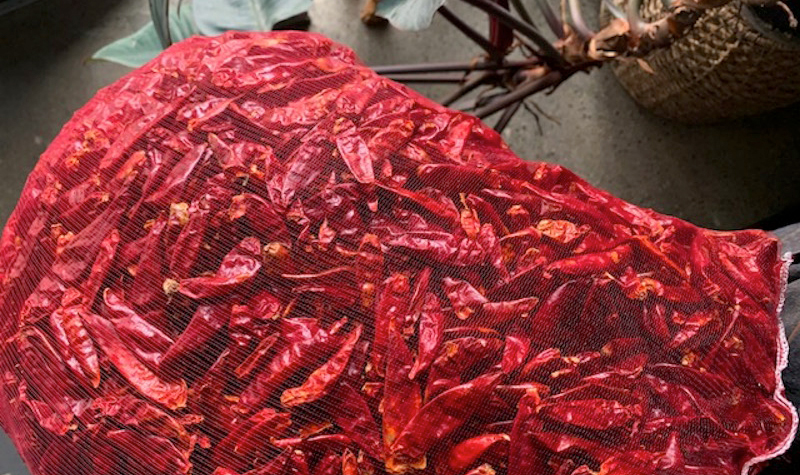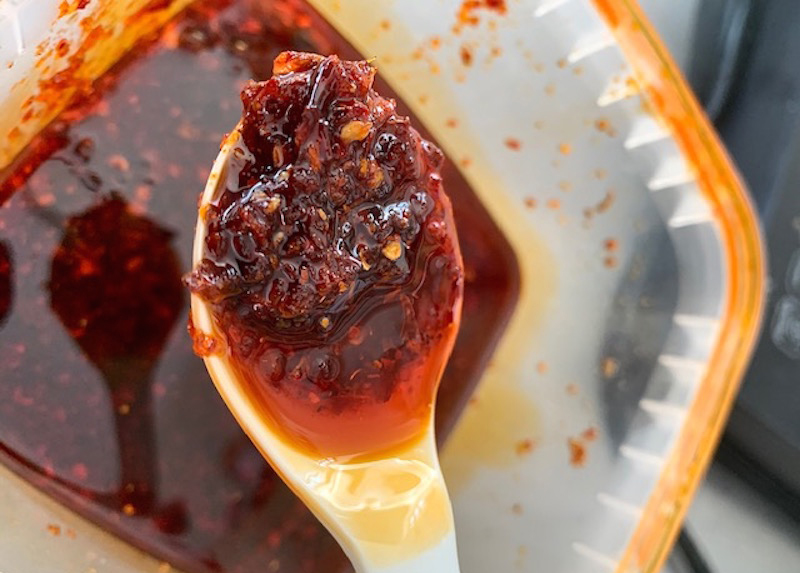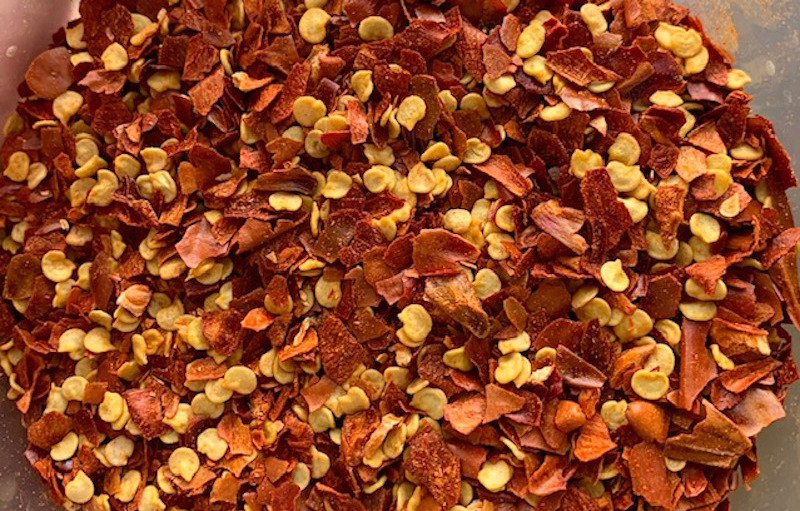PHOTOS BY CHANDRA WALBOLT / HEAVY TABLE
This column is underwritten with generous support from United Noodles, Minnesota’s largest Asian grocery store, awarded “Best International Grocery” by City Pages in 2014, 2016, and 2020. Chandra Walbolt is a professional chef with experience at several restaurants in the Twin Cities, and she currently serves as a manager at Union Hmong Kitchen. She will soon be the Executive Sous Chef at Yia Vang’s Vinai in Northeast Minneapolis.
If I’m being completely and embarrassingly honest… I didn’t know what Scoville Heat Units were until I watched Hot Ones on YouTube. If you haven’t seen it: the host asks celebrities a series of questions while they both eat wings with different sauces that just get hotter and hotter. Before season 4, their 7th-8th hot sauce (out of 10) would be around 80k-100k Scoville Heat Units. A single Thai chili ranges from 50k to 100k. So the fun fact I deduct from this is if you can eat a ripe Thai chili, you can get through the 8th sauce on Hot Ones, so congrats if you can! I am not suggesting you try it because it can actually be dangerous if you’re not well seasoned with spice. This small chili at its ripest can get as hot as the mildest habanero (100,000 SHU… which is roughly 15-23 times hotter than a jalapeño).
Thai chilis are also known as bird’s eye chilis. They are small (about 1-2 inches on average in length) thin, and filled with seeds, which pick up some of the ultra-hot oil that is concentrated in the pith of the pepper. Since there are a lot of seeds packed into each delicate pepper, I find it easier to keep all the seeds in when I chop it and then add in a little bit of the pepper at a time to taste.
Red chilis are the most ripe and at its peak heat level, up to double that of the unripe green chili. The green Thai chili is still commonly used in green curries and sauces, and in my personal opinion doesn’t have much flavor difference than the fully ripened fruit. But that could also be because my palate can’t handle much more than 100k scoville units. I have found that it’s cheaper to get fresh green Thai chilies than red, and they’re easier to find an abundance of.
If you have had Thai red curry or green curry, you’ve had Thai chilis. Thai Chilis are used to provide heat in most curry pastes, combined with other more mild chilis, like Guajillo, that round out the flavor without overdoing it on the spice. After being introduced by the Portuguese in the 1500s, Thai chilis are used in almost all Southeast Asian foods, sauces, and bases. This can be for several different reasons. Because of the constant tropical weather, meat and vegetables spoil fast. Spices and chilis can help preserve these foods.
Fortunately, Thai chilis grow well in these hot and humid climates. Also, since rice is plentiful in Southeast Asia, they would use these chilies to add flavor to it so they can cut down consumption of other produce and protein, making each meal a lot cheaper.
 Thai chilis can be purchased dried, whether it be whole or crushed. Dried chilis are my personal favorite because it lasts longer and they’re always pretty and bright red. You can find dried Thai chilis in the dry spice section of any Asian market. If it is only available as whole dried peppers, you can crush them with a spice grinder, food processor, blender or mortar and pestle to the texture you prefer. After processing, you’ll want to make sure you clean your equipment well to reduce the chance of unwanted spice in other food you prepare. Try scrubbing first with a form of fat (butter or oil) to absorb the capsaicin, and then wash off with soap and water.
Thai chilis can be purchased dried, whether it be whole or crushed. Dried chilis are my personal favorite because it lasts longer and they’re always pretty and bright red. You can find dried Thai chilis in the dry spice section of any Asian market. If it is only available as whole dried peppers, you can crush them with a spice grinder, food processor, blender or mortar and pestle to the texture you prefer. After processing, you’ll want to make sure you clean your equipment well to reduce the chance of unwanted spice in other food you prepare. Try scrubbing first with a form of fat (butter or oil) to absorb the capsaicin, and then wash off with soap and water.
The peppers can also be purchased fresh. When I do buy them fresh, I prefer to store them in the freezer in an airtight container. They chop easily from frozen and last indefinitely. The fresh peppers are found usually in the refrigerated produce section of the grocery. These peppers can be used raw as garnish or in a dressing. You can also roast, saute, stew or fry them.
Please use gloves when handling any hot pepper, or wash your hands immediately before touching your face or anything else. Something that helps is covering your hands in neutral oil, coconut oil, or butter and rubbing it in for a few minutes and then washing off with soap and water. I repeat this once or twice until the smell of pepper is off of my hands.
Here are some tried and true flavor trios that pair beautifully with Thai chilies if you’re looking to balance flavors in your dish.
Thai chilis + tomatoes + cilantro
Thai chilis + garlic + shallots
Thai chilis + pineapple/mango + tamarind
Thai chilis + fish sauce + lime juice
Thai chilis + garlic + oil
 We are going to make the flavor trio of chili, garlic, and oil and make a basic and flavorful chili oil. Chili oil is a condiment I like to keep on hand as often as possible. When food just needs that extra “UMPH”, chili oil is there to save the day. I just love it so much. Not only does it add a beautiful and vibrant red layer to curries and ramen, it adds so much flavor and color to some things as simple as rice and Kai Jaew (above).
We are going to make the flavor trio of chili, garlic, and oil and make a basic and flavorful chili oil. Chili oil is a condiment I like to keep on hand as often as possible. When food just needs that extra “UMPH”, chili oil is there to save the day. I just love it so much. Not only does it add a beautiful and vibrant red layer to curries and ramen, it adds so much flavor and color to some things as simple as rice and Kai Jaew (above).
The fun thing about this chili oil recipe is you can add more or less of any of the ingredients based on how you like your spicy condiment.
 GARLIC CHILI OIL
GARLIC CHILI OIL
1 ½ cup neutral oil (use more or less to your liking of chunkiness)
2 cloves garlic, sliced thinly or minced
1 cup crushed dried Thai chilies
Salt to taste (I usually find 1 tsp is plenty)
Heat oil in a sauce pot to about 225 F – 250 F.
Meanwhile, put crushed chilies in a heat proof bowl (I use stainless steel) and cut your garlic.
At this point you can mince garlic or slice thinly. I prefer to thinly slice because it looks cool and I just love garlic that much.
Add a little bit of garlic to your hot oil and stir around, make sure your oil isn’t going to immediately burn your garlic because then it will be bitter. It should simmer slowly, and be stirred frequently until golden brown.
After golden brown, strain the hot oil from garlic over your chilies using a fine mesh strainer.
PLEASE BE CAREFUL. The chilies will bubble up, but we want that. It will make the flakes crunchy.
Stir around, scraping the bottom so all the chilies come in contact with hot oil. Add salt while still warm and stir to dissolve.
After the garlic has cooled and become crunchy in your fine mesh strainer, mix into chili oil.
You can store it in an airtight container in the fridge or in a cool dry place on your counter.

